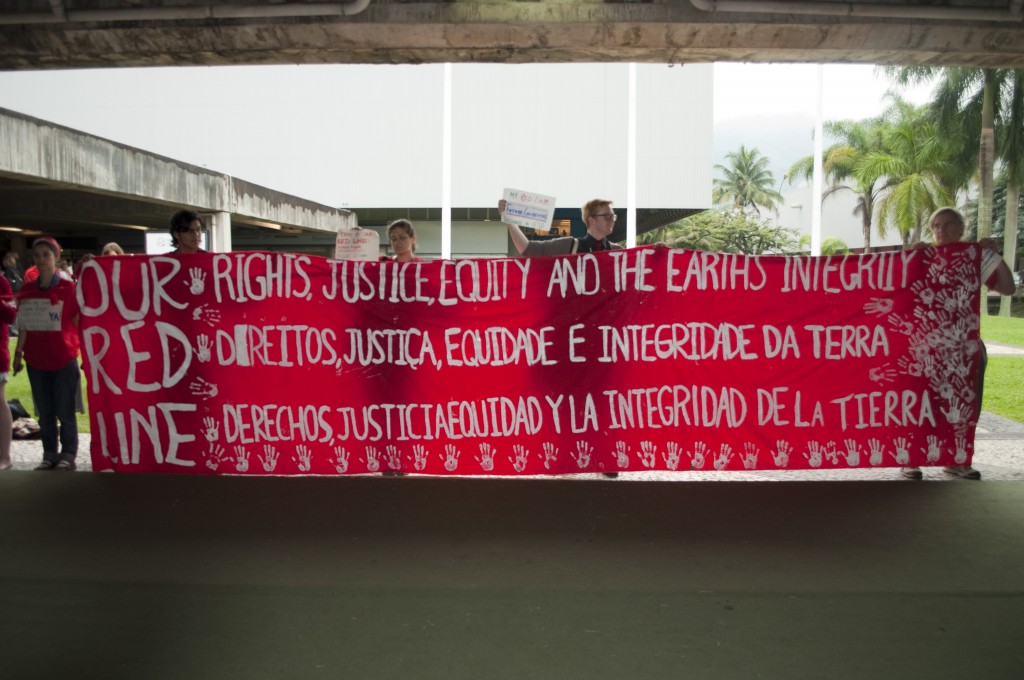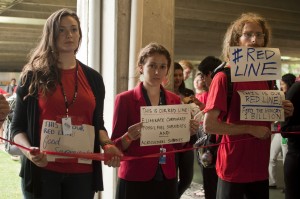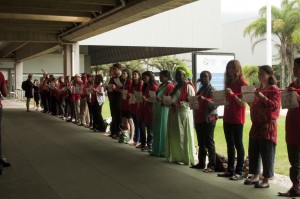By Anna Odell
After my first week in Rio, which I spent almost entirely cooped up in buildings, I was ready for a change of scenery. After spending just three days at the PrepComm in Riocentro with UN delegates and negotiators made me crave the sunlight and some fresh air. I was looking forward to feeling some sand beneath my toes and to finding some inspiration at People’s Summit. When I arrived at the People’s Summit, I was immediately struck with the impressive distance between the two spaces. Not only is there 40 km between the two (perhaps to ensure that negotiators won’t have to see the opposition to their work), there was sunlight, colors, grass, bikes, dogs, and a beach. I felt like I was entering a fair, complete with balloons and clowns.
I had been warned to write down the schedule before attending and to bring a map; there was no visible complete list of side events, workshops, and plenaries and everything was extremely hard to find. When I arrive at the People’s Summit, there seemed to be some small improvement: there was a large map of Flamengo Park and the tents were clearly labeled. Alas, the increase in organization seemed to have stopped there. Every single workshop I attended (or tried to attend) had either been moved, was starting late, or had been cancelled. Throughout the day I grew increasingly concerned with the disorganization of the People’s Summit, and realized that without a unified, strong message, there is no way that their voices would be heard within Riocentro, let alone taken seriously.
After the initial reactions of the differences between the People’s Summit and Riocentro, I paused to take note of the similarities. Both of the spaces sprawl across large areas, with little organization and communication. In the formal UN space, events are often closed, text must be leaked out, and rooms are often switched without notice. The People’s Summit is similar in the way that the spaces are seemingly disconnected, communication is incredibly difficult, and at times it is difficult to have any idea what is going on. If the People’s summit is to make an impact, it must get it together and raise a voice as unified civil society.
A key difference, however, between the People’s Summit and Riocentro, is the ability to express ideas and thoughts, whenever and however you feel fit. At Riocentro, an action expressing support for the 10 Year Framework of Sustainable Consumption and Production that involved about 5 people holding a poster was shut down in approximately five minutes. On the other hand, the People’s Summit is a space to express fears, disappointment, hope and rage. This is a place for people to come together and speak in a language that they can understand (primarily Portuguese), without the political jargon with hidden meanings. I was refreshed by the genuine sharing of knowledge and emotions, especially after my time in Riocentro, where real action and exchange seems to be stifled by the negotiations or lost in the vast buildings.
My hope for the People’s Summit is that the energy created will put pressure on the negotiations and have an impact, and that the discontent of the People’s Summit will be heard within the halls of Riocentro. I hope that this will be a place for civil society to tell the world what the future they really want is. I have faith that this can happen, but only with a conscious effort and with this goal in mind. How do we make a clear message and how will that message be heard in Riocentro?
By Maria Alejandra Escalante
Of course, the People’s Summit and RioCentro had to be two different places. One is the gathering of people who have preferred to dedicate their efforts building relationships in an informal space. The other is the coucous of domesticated suited individuals who adapt their discourses to hidden corporate interests. We all knew that from previous civic and governmental reunions; we all expected the same dichotomy at Rio+20.
We also know that the people’s movements at the People’s Summit could greatly be seen as an alternative proposal for the processes owned by the UN structure. By their inherent characteristics, both venues differ. But their differentiation implies, unfortunately, that one has a greater weight in the balance of what influences society’s structures.
The media has made the UN organization heavier. The world is expecting that the UN, precisely Rio+20, will come out with a plan for the coming years, a solution for the global crisis, at least a concern on the most pressing issues. By the world I mean all of those thousand of people who inevitably wait for the TV news to inform them of the process and the outcome of “such an important meeting”. The world is attentive to what Hillary Clinton has to say (in representation of Obama who could not come because of …..who knows). The world does not seem to be open to receive real structural changes out of the dozen of workshops offered by NGO’s and local groups who drive projects for the wellbeing of the communities.
Given this unbalance of influences, the People’s Summit must mobilize and express their disagreement and anger with the negotiation process. They march, they move, they yell and hope to be heard. Meanwhile, here at RioCentro, no one cares about mobilizing in disagreement with the People’s Summit principles because the ones here, at this cold halls, know the power they hold.
The civil society at People’s Summit protests, and therefore increases the value of the UN decisions by giving this institution the attention it is craving for. The UN takes advantage in this position to escalate higher in the dreadful scale of powers. What if us, as civil society, turn our backs to the UN and their principles which have failed to represent us, and instead face one another? Would a stronger partnership between civil society members be more powerful than accepting another document of non achieved principles and commitments from the international governmental community? It might be the time to stop feeding these delegates’ ego. Their decisions can reach as far as civil society lets them. If we do not accept their unreasonable agreements then their power falls to the ground. We as civil society are already standing on the ground, we know we have alternative solutions to these global crisis. It might be time to pull the UN down from the air and bring it here, at the same level where we are standing on.





